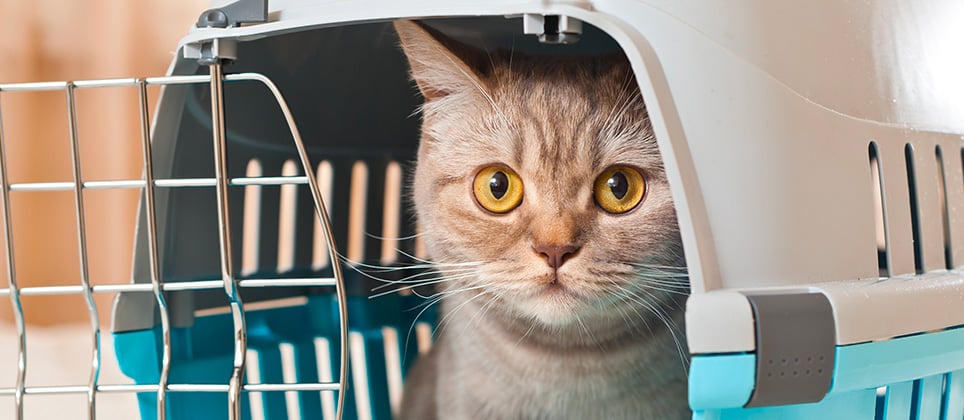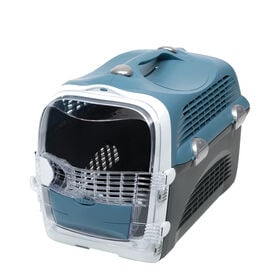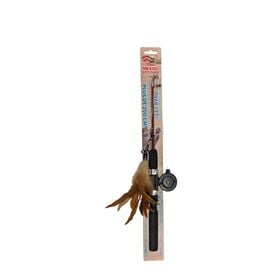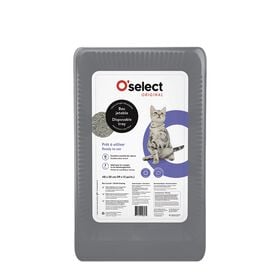Remember the first time you flew in an airplane? You likely experienced a combination of stress and excitement. The same is true for cats in cars. Some like the experience, other not as much, and still others don’t enjoy it at all.
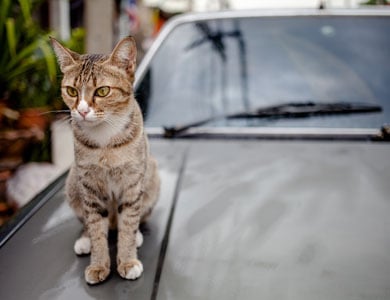
One meow means several things
You’re familiar with the fact that many cats meow plaintively in the car. Since cats meow to express different types of discomfort, it’s very difficult to know what’s bothering your cat.
Some reasons for meowing include:
- Fear
- Stress
- Dizziness
- Nausea
- Need for attention and reassurance
Like humans, cats can also suffer from motion sickness, and vomit in the car. In such cases, your veterinarian can help with the fear and stress of car travel by prescribing a mild medication that you can administer a few hours before departure.
Cat carrier: a safe place for cats
The size of the carrier is key: it shouldn’t be too big or too small. The cat should be able to stand in it comfortably. Choose a carrier with a lid that opens or can be removed easily.
Instead of taking the carrier out on the day of the car ride, leave it somewhere in the house, with the door open and a blanket inside. Every day, toss a treat into it or give your cat its meals in the carrier. That way, the cat will connect the carrier to a pleasant event. On the day of your trip, when you want the cat to go into the carrier , you just have to toss in a treat and your cat will dash in without hesitation. You’ll avoid all the stress that comes with capturing your cat and painfully getting it into the carrier. In addition, the carrier may even become a safe place for your cat when he's not in his usual environment.
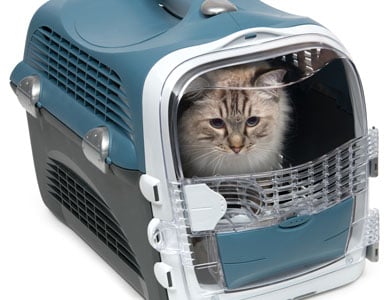
Never leave your cat loose in the car!
Did you know that the law prohibits you from driving with an animal loose in the car ? The animal must be attached or in a carrier, which, in turn, must be secured to the back seat with a seat belt. It is therefore prohibited to place a carrier on the front seat. In the event of an accident, the air bag deployment could pose a real risk of injury for your pet, even if it’s in a carrier. Several carriers have slots on the top or sides for seat belts. It’s a lot safer, both for you and your cat, to move the passenger seat up and place the carrier on the floor of the back seat, wedged between the front and back seats.
Many people will open the carrier door to pet their cat. If it calms the animal down, then it’s not a problem. However, be sure than the cat stays in its carrier at all times, even if you think that taking the animal out will help manage its stress. In fact, it will only increase the cat’s stress level, and the cat will become a potentially fatal projectile in the event of an accident.
Then, it’s vitally important to ensure that the temperature inside the car remains moderate. You want to avoid having the passenger compartment become overly hot in the summer at all cost. Just one bad experience could cause your cat to develop a serious aversion to the car, and that can be very difficult to overcome. Always take the time to air condition the car before leaving with your cat.
A technique that requires patience
There is a very easy technique that will allow your cat to tolerate and even enjoy car rides. It’s one you should learn if you know that there are frequent car trips ahead for cat (going to the cottage or summer home, or making numerous trips to the vet because your cat is sick).
Even if you apply the technique only partially, it’s better than doing nothing at all. Before you start, follow the previously mentioned tips regarding the carrier and make sure the car is at a comfortable temperature. Have your cat’s favourite treats (or the wet food that the cat really likes) and a wand toy on hand.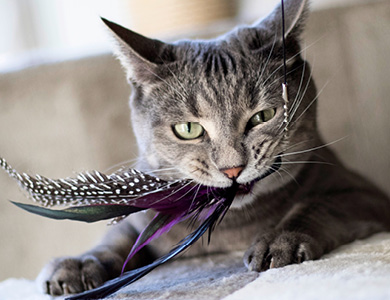
Desensitizing your cat
- Bring the cat in its carrier to the back seat of the car and sit next to the cat. Start playing with a wand toy (not your fingers) through the cat carrier bars, and offer the cat give treats or food. Repeat this routine without moving the car until the cat is comfortable with it.
- Repeat the first step. This time, however, since your cat should be used to it, don’t immediately offer a game and treats. Move the car a very short distance, and offer the cat some food to associate this change with something pleasant. Give the cat time to calm down between each move.
- This step is identical to the previous step, but this time, move the car a longer distance. For example, go around the block and come back home.
- Continue with longer and longer distances. Also, choose busier roads and increase your speed.
- Now you’re at the step where you hit the highway. It’s important to know that many cats have difficulty with speed and tend to react more nervously when a car reaches a speed of more than 80 km/hr. That’s why you have to be really sure that your cat is completely comfortable with the previous steps before venturing out onto the highway.
This desensitization and counterconditioning technique will allow your cat to gradually get used to the car by associating it with something extremely pleasant. As you will see, each step is divided up, ultimately leading to a car ride that your cat can handle more easily. It’s important to ensure that the cat shows no signs of stress and that it feels very comfortable before you move on to the next step.
If your cat is too stressed or fearful, it won’t eat. If that’s the case, stick with the game plan. Play even if your cat doesn’t seem interested and give it time to get used to the new environment. Offer the cat food from time to time. If it eats, that’s an excellent sign. If the cat doesn’t come around to the new situation, go back a step or insert an intermediate step to help the cat progress more gradually.
You have to respect the time it takes for your cat to adapt, which often means that you have to repeat a given step several times before moving on to the next one. To speed up the process, two people can be involved: a driver at the front and a person at the back who plays with the cat and gives it food. Each session should last about 5 to 15 minutes at the first, and be extended over time if all goes well.
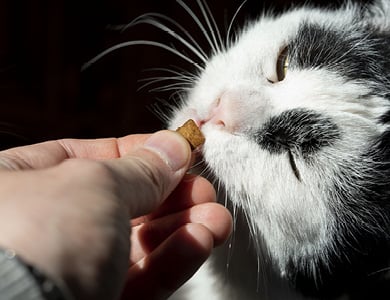
Short and long trips
Whether for a short or long trip, bring along some paper towels in case the cat pees, poops or vomits in the carrier. If that happens and you have to take the cat out of its cage to wash it and clean up the cage, make sure to keep all the car doors closed at all times, even if that makes handling uncomfortable. A fearful cat that sees an opening can come to its senses very quickly and try to get out of a situation. It can even get aggressive. If you have to travel for several hours, plan to have a litterbox on hand. You will find small litterboxes in store that are specially designed for car travel.
The key to success is to take your time and go about things gradually with your cat. No matter what you do, your cat may never enjoy car rides, in which case you’re better off going to the vet only when it’s absolutely necessary and having someone mind your cat when you have to be away for a long time.
